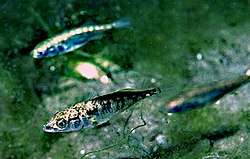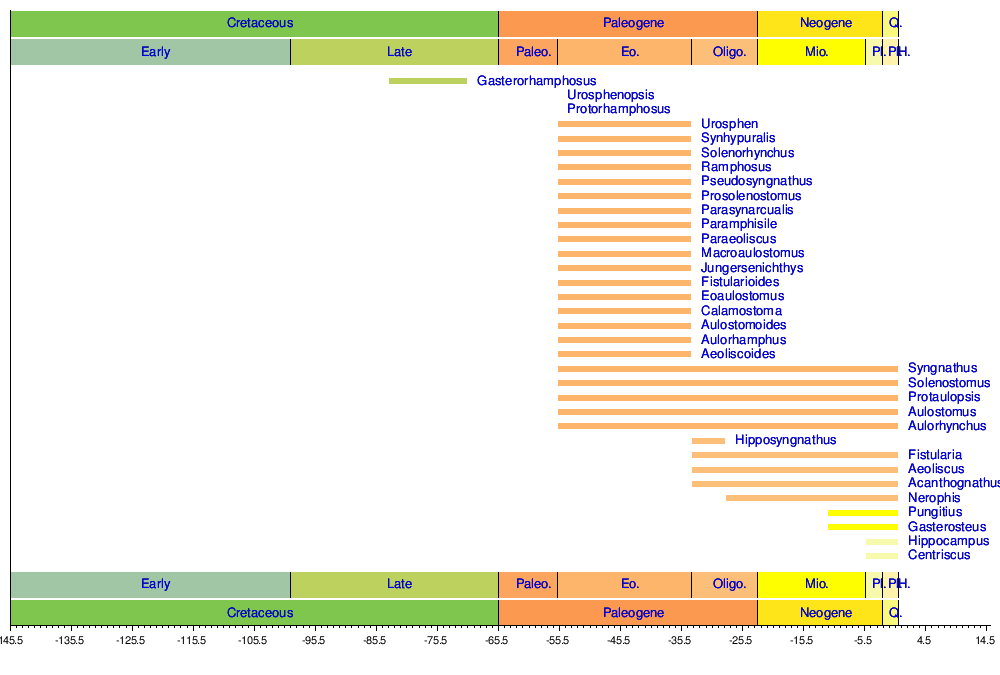Gasterosteiformes
Gasterosteiformes is an order of ray-finned fishes that includes the sticklebacks and relatives.
| Gasterosteiformes | |
|---|---|
 | |
| Three-spined sticklebacks, Gasterosteus aculeatus | |
| Scientific classification | |
| Kingdom: | Animalia |
| Phylum: | Chordata |
| Class: | Actinopterygii |
| Superorder: | Acanthopterygii |
| Order: | Gasterosteiformes |
| Type species | |
| Gasterosteus aculeatus | |
| Families | |
In the Gasterosteiformes, the pelvic girdle is never attached to the cleithra directly, and the supramaxillary, orbitosphenoid, and basisphenoid bones are absent. The body is often partly or completely covered with dermal plates.
The name "Gasterosteiformes" means "bone-bellies". It is derived from Ancient Greek gaster (γαστήρ; "stomach", "abdomen") + ostoun (ὀστοῦν; "bone"). The ending for fish orders "-formes" is derived from Latin and indicates "of similar form".
Systematics
Gasterosteiformes often includes the sea horses, pipefishes and their relatives as suborder Syngnathoidei, with the sticklebacks and relatives in the suborder Gasterosteoidei.[1] In many more recent treatments the traditional placement[2] as different orders, with the former becoming Syngnathiformes, is used.[3] There is a growing body of evidence that this is correct; in fact, the two groups do not seem to be particularly close relatives among the Acanthopterygii.
As it seems, the loosely delimited Gasterosteiformes are paraphyletic with the Scorpaeniformes. The more typical members of that group (e.g. scorpionfishes) are apparently closer to the "true" Gasterosteiformes, whereas the keel-bodied flying gurnards (Dactylopteridae) seem actually to belong to the Syngnathiformes clade. It seems that the closest living relatives of the narrowly delimited Gasterosteiformes are the gunnels (Pholidae) and eelpouts (Zoarcidae), traditionally placed in the massively paraphyletic "Perciformes". These two families, as well as the related Trichodontidae, would then appear to be derived offshoots of the scorpaeniform-gasterosteiform radiation which have apomorphically lost the bone "armour" found in their relatives.[4]
Three families certainly belong to the Gasterosteiformes sensu stricto:
- Aulorhynchidae – tube-snouts
- Gasterosteidae – sticklebacks
- Hypoptychidae – the sand eel
The armoured sticklebacks (Indostomidae) and the dragonfishes and sea moths (Pegasidae) are variously placed with the pipefish or stickleback lineage. While the Pegasidae are almost certainly Syngnathiformes, the proper placement of the monotypic former family remains unresolved.[4] Following the practice of the major fish classification organizations, it is included here.
Timeline of genera

Footnotes
- E.g. ITIS (2004), Nelson (2006)
- E.g. McAllister (1968)
- E.g. FishBase (2005a,b)
- Kawahara (2008)
References
- FishBase (2005a): Order Summary for Gasterosteiformes. Version of 2005-FEB-15. Retrieved 2008-AUG-19.
- FishBase (2005b): Order Summary for Syngnathiformes. Version of 2005-FEB-15. Retrieved 2008-AUG-19.
- Integrated Taxonomic Information System (ITIS) (2004): Gasterosteiformes (TSN 166361). Retrieved 2006-APR-08
- Kawahara, Ryouka; Miya, Masaki; Mabuchi, Kohji; Lavoue, Sébastien; Inoue, Jun G.; Satoh, Takashi P.; Kawaguchi, Akira & Nishida, Mutsumi (2008): Interrelationships of the 11 gasterosteiform families (sticklebacks, pipefishes, and their relatives): A new perspective based on mitogenome sequences from 75 higher teleosts. Mol. Phylogenet. Evol. 46(1): 224–236. doi:10.1016/j.ympev.2007.07.009 (HTML abstract)
- McAllister, D.E. (1968): Evolution of branchiostegals and classification of teleostome fishes. Bulletin of the National Museum of Canada, Ottawa 221: 1–239.
- Nelson, Joseph S. (2006): Fishes of the World. John Wiley & Sons, Inc. ISBN 0-471-25031-7
- Sepkoski, Jack (2002). "A compendium of fossil marine animal genera". Bulletins of American Paleontology. 364: 560. Archived from the original on 2011-07-23. Retrieved 2011-05-17.
External links
| Wikimedia Commons has media related to Gasterosteiformes. |
- Gasterosteiformes entry on Animal Diversity Web
